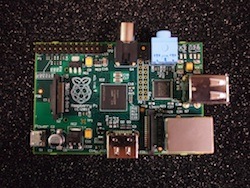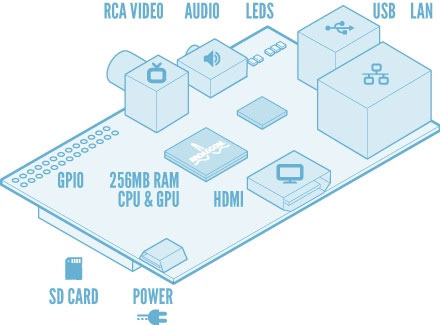Irrational Numbers: The Promise of a Commodity Computer
 I mentioned the Raspberry Pi a while ago, and it continues to fascinate me. Particularly in light of recent remarks by Phil Callihan, NCMS executive director, MIS, about how making stuff is not necessarily an easy task, I’d like to revisit the subject in a little more depth.
I mentioned the Raspberry Pi a while ago, and it continues to fascinate me. Particularly in light of recent remarks by Phil Callihan, NCMS executive director, MIS, about how making stuff is not necessarily an easy task, I’d like to revisit the subject in a little more depth.
Quick review: the Raspberry Pi Foundation’s objective is to create a computer with enough power and flexibility to be useful, while still being small enough and cheap enough that it’s a commodity product.
Objective achieved. Raspberry Pi runs a 700MHz ARM processor, 256MB of onboard memory, Ethernet, and 3D-capable video capable of delivering Blu-Ray quality playback. It can run assorted Linux distros and a bunch of other OSes from a user-supplied SMD. About the size of a fat credit card, it’s going to cost just $35. It is, as the Foundation’s own FAQ describes it, “a capable little PC.”
 Now, I think when it comes to something like Raspberry Pi, there are people who kind of get it and people who kind of don’t. I was describing it to a colleague a while back and he blankly said, “My phone has more than a 700MHz processor and way more than 256 megs of memory.”
Now, I think when it comes to something like Raspberry Pi, there are people who kind of get it and people who kind of don’t. I was describing it to a colleague a while back and he blankly said, “My phone has more than a 700MHz processor and way more than 256 megs of memory.”
Okay, yes, true, fine, it does. Your phone also doesn’t cost thirty-five bucks, its proprietary OS severely limits what you can do with it, it’s got a contract that you signed in blood, and it’s a phone. Raspberry Pi is not a phone. Raspberry Pi is a fully-functional PC that’s going to turn out to be limited only by what weird things people can come up with to make it do. The Foundation’s initial objective was to provide something that’ll help encourage kids to learn programming, but that’s only the beginning of what it might offer.
You read DMR, you’re already thinking what I’m thinking. Once they’re in full-scale production, you could get a hundred of these things for less than four grand. That’s a lot of parallelism for the adventurous.
Of course, that’s also the rub – that “full-scale production” part. Raspberry Pi is in manufacturing, but it’s going a lot slower than anyone would like. Why? Well, because making stuff is hard! The first batch of 10,000 experienced their share of hiccups, from the wrong Ethernet connectors to increasing demand suddenly forcing the Foundation to put them through a much more rigorous testing and approval process. Just now the devices are trickling in to the two currently authorized resellers, who are limiting sales to one per person and following a strict first-registered-first-served policy.
They won’t tell me exactly where I am in line, but I’m pretty sure there are at least half a million people ahead of me, so I’m unlikely to be getting my Raspberry Pi any time soon. I don’t mind too much. Making stuff is hard! By this time next year I’ll be able to buy five of the things if I want.
And I just might. Though the promise inherent in Raspberry Pi is sort of elusive to me – I’m not an engineer, not a programmer, not even a Linux user – I do sense that promise. I recognize that the simple fact of a 700Mhz computer that costs less than the movies for two, existing at all means something.
 I may not be an engineer, coder, or Linux user, but I am a gamer. And I have a dim memory of a time maybe seventeen years ago, when I was still in college, and poverty-stricken, and just getting into PC gaming. I was looking at the cover of some PC enthusiast magazine, its blaring headline (300MHz NT POWERHOUSES TESTED!!) all but leaping out to mock me. My rig was a 486DX2 at 66MHz. With four megs of RAM. Three hundred megahertz seemed beyond even the Promised Land; it was an ice-cream-covered, chocolate-frosted, thousands-of-dollars-costing Xanadu that I’d never even be allowed to see, forget own.
I may not be an engineer, coder, or Linux user, but I am a gamer. And I have a dim memory of a time maybe seventeen years ago, when I was still in college, and poverty-stricken, and just getting into PC gaming. I was looking at the cover of some PC enthusiast magazine, its blaring headline (300MHz NT POWERHOUSES TESTED!!) all but leaping out to mock me. My rig was a 486DX2 at 66MHz. With four megs of RAM. Three hundred megahertz seemed beyond even the Promised Land; it was an ice-cream-covered, chocolate-frosted, thousands-of-dollars-costing Xanadu that I’d never even be allowed to see, forget own.
Maybe that’s what gets me excited about Raspberry Pi. There was once at time when 300MHz wasn’t just unbelievable, it was AN NT POWERHOUSE to be TESTED!! and it was six thousand dollars and the size of a Saint Bernard.
Now I can slide something more than twice as awesome in my jeans pocket.
What’ll it do in there? Heck, I don’t know. To me, it’s enough to know that there are others out there who’re going to make it sing.










